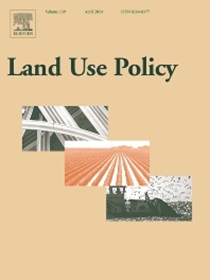Understanding organic agriculture based on coupled human-earth systems for sustainable land use and rural development in China
IF 6
1区 社会学
Q1 ENVIRONMENTAL STUDIES
引用次数: 0
Abstract
Organic agriculture is recognized as a nature-based innovative production system that balances multiple sustainable development goals. However, few studies were conducted to investigate organic agriculture based on coupled human-earth systems. Here we introduced a hierarchical framework consisting of natural basis, management means, and demand objectives to understand organic agriculture. We reported the spatiotemporal patterns of organic agriculture and their socioeconomic and eco-environmental correlates and effects in China. Our study showed that organic production increased from 1.124 to 2.756 million ha in 2014–2021 with the most increase in soybeans, corn, and tea. The number of organic product certificates was higher in northeastern, southwestern, and eastern coastal China, and the fastest-growing occurred in western and south-central China. Of the 14 factors, management means and demand objectives ranked by organic enterprises, organic demonstration areas, food consumptions, pesticide applications, and large-scale farming operations had greater influences on organic agriculture. The interaction of human-environmental factors enhanced their impact. Organic farming increased soil carbon sequestration and reduced greenhouse gas emissions compared with conventional farming. Although average organic yields and output values per unit area were lower by 10.5–61.7 % and 5.1–48.9 % respectively for most crops, higher yields of corn, soybeans, and tea, and output values of vegetables were achieved in organic farming. We suggest synergizing organic agricultural system management to foster sustainable land use and rural development.
基于人地耦合系统的中国有机农业可持续土地利用与农村发展研究
有机农业被认为是一种以自然为基础的创新生产体系,能够平衡多个可持续发展目标。然而,基于人地耦合系统的有机农业研究却很少。本文介绍了一个由自然基础、管理手段和需求目标组成的层次框架来理解有机农业。本文报道了中国有机农业的时空格局及其社会经济和生态环境相关因素和效应。我们的研究表明,2014-2021年有机产量从1124万公顷增加到275.6万公顷,其中大豆、玉米和茶叶的增幅最大。有机产品认证数量在东北、西南和东部沿海地区较高,在西部和中南部增长最快。在14个影响因素中,有机企业、有机示范区、食品消费、农药施用和规模化经营对有机农业的影响较大。人-环境因子的交互作用增强了其影响。与传统农业相比,有机农业增加了土壤碳固存,减少了温室气体排放。虽然大多数作物的平均有机产量和单位面积产值分别降低了10.5-61.7 %和5.1-48.9 %,但有机耕作的玉米、大豆和茶叶的产量和蔬菜的产值都有所提高。我们建议协同有机农业系统管理,促进土地可持续利用和农村发展。
本文章由计算机程序翻译,如有差异,请以英文原文为准。
求助全文
约1分钟内获得全文
求助全文
来源期刊

Land Use Policy
ENVIRONMENTAL STUDIES-
CiteScore
13.70
自引率
8.50%
发文量
553
期刊介绍:
Land Use Policy is an international and interdisciplinary journal concerned with the social, economic, political, legal, physical and planning aspects of urban and rural land use.
Land Use Policy examines issues in geography, agriculture, forestry, irrigation, environmental conservation, housing, urban development and transport in both developed and developing countries through major refereed articles and shorter viewpoint pieces.
 求助内容:
求助内容: 应助结果提醒方式:
应助结果提醒方式:


